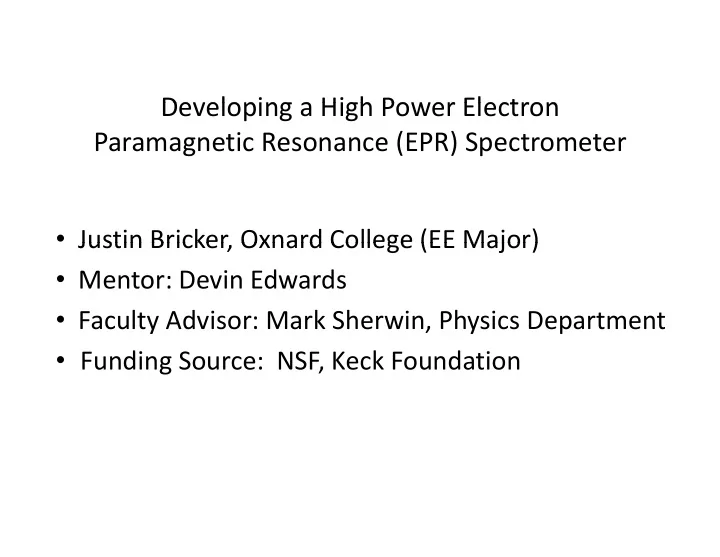

Developing a High Power Electron Developing a High Power Electron Paramagnetic Resonance (EPR) Spectrometer • Justin Bricker Oxnard College (EE Major) Justin Bricker, Oxnard College (EE Major) • Mentor: Devin Edwards • Faculty Advisor: Mark Sherwin, Physics Department F lt Ad i M k Sh i Ph i D t t • Funding Source: NSF, Keck Foundation
Background What is EPR? Radiation source and detector How spins react to radiation H i t t di ti Free Electron Laser (FEL) 240 GHz, kW power 240 GHz kW power Two-Pulse EPR Experiment T P l EPR E i t Fast spin dynamics Ex. proteins One pulse strikes the sample Second pulse strikes sample to re-phase Second pulse strikes sample to re phase Spectrometer measures the “echo” z y x x x x y
Our Focus Sherwin Group’s Focus: • D Develop the two pulse system l th t l t • Samples with fast reaction time • Create two very short pulses • Reduce radiation leakage Challenges of created two pulses FEL pulse is ~1 μ s, we need <5 ns • Use switches activated by green • lasers lasers Many sources of background noise 1 μ s •
Pulse Slicing On 240 GHz Switch FEL Radiation Source Off Switch ower Po Sample Time
FEL Radiation Beam Path FEL Radiation Source Source S3 S3 S6 S6 S2 S5 S1 S4 Sample Sample Green Laser Green Laser Green Laser
Green Laser Beam Path On Switch Green Laser Off Switch Prism 1 ft. 1 ns First Pulse: Changing Length • ~4-8 ns pulses • Want to increase variability
Two-Pulse Experiment p
Progress • Altered and aligned green laser beam g g • Created diagrams of beam path for analysis
Progress • Designed and constructed isolation boxes • Designed and constructed radiation- d dumping apparatus (witch’s hat) i t ( it h’ h t)
Radiation Dumping FEL Radiation Radiation Source •Without hat radiation leaks into room, detector •Hat installed radiation is absorbed, reduces Hat installed radiation is absorbed reduces background noise
Effect of Radiation Dumping: First On Switch Effect of Radiation Dumping: First On Switch • Sufficiently minimizes background noise
Conclusions and Outlook Conclusions and Outlook Improvements This Summer: Improvements This Summer: • Reduced background noise • Improved green laser accuracy • Created diagrams for analysis Created diagrams for analysis What’s Next • Implement switch • Increase pulse length variability • Run two-pulse EPR experiment to show improvements
Thank you! Thank you! Acknowledgements: g • The Mark Sherwin Research Group Louis Claude Brunel, Devin Edwards, Sahar El Abbadi, Vihn Nguyen, Mark Sherwin, Susumu Takahashi • INSET Program INSET P Ofelia Aguirre, Nick Arnold, Arica Lubin, Jens ‐ Uwe Kuhn • Funding Sources National Science Foundation, Keck Foundation
Recommend
More recommend